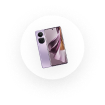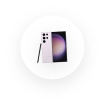Mobile phones have come a long way since the Motorola Dynatac 8000X – the first commercially available handheld device - which cost about 4,000 USD and weighed over 900 grams. As technology has improved since 1983 when the Motorola Dynatac 8000X was released, making phone calls has become one of the most rudimentary things our incredible smartphones can do.
With the modern features we now have access to, there’s no denying mobile phones have changed the world. And while everyone can appreciate how mobile phones means everyone can communicate with each other at a moment’s notice, there are other less obvious benefits too.
For instance, the very nature of language has changed since the release of SMS in 1992. From an endless array of abbreviations to emojis, our language has been condensed to help streamline communication without a loss of meaning. Meanwhile, people can browse the internet to find work, bank online, and even buy second-hand goods.
With mobile phones bringing about dramatic changes to our everyday existence, we look back on the progress of this technology and look ahead towards the future.
How Mobile Technology Evolved in the 80s and 90s
The Motorola Dynatac 8000X was the first ‘mobile’ phone to become available to customers, but it didn’t take long for other companies to get moving. In 1985, Vodafone entered the market with the VM1 – a bulky in-car unit that was prominent in many 1980s movies. Then, in 1988, Motorola returned with the 4500X. Featuring an LCD screen and phone number storage, it offered customers a genuinely revolutionary solution.
As the mobile phone was increasingly refined, the late 1980s through to the 1990s introduced a host of smaller devices. One of the most successful was the Motorola MicroTAC 9800X – featuring a flip design and 30 hours of standby time, it was small enough to fit into your pocket. Motorola dominated the mobile phone industry throughout the 80s and 90s, but Nokia was just getting started.
The release of the Nokia 1011 was a landmark event in the history of mobile phones. This revolutionary device featured GSM technology for the first time, alongside a monochrome LCD screen and storage for 99 phone numbers. The Nokia 1011 could even send and receive SMS messages. However, this technology wouldn’t catch on for a few more years.
Shaping Smartphones from the 2000s
While Nokia released a host of mobile phones, including the 5510 and 3210 in the 1990s, it wasn't until the turn of the millennium when they released the 3310 that Nokia took the industry by storm, selling 126 million units worldwide.
Spurred by high growth, mobile phones soon took another massive leap forward with the introduction of cameras, colour screens, and Wireless Application Protocol (WAP) technology, giving users access to a simplified version of the internet.
Throughout the 2000s, mobile phones would grow slimmer, with every new device thinner and more compact than the last. During this period, the Motorola Razr, which sold 130 million units, introduced MP3 players to our handheld devices. However, it was the release of iPhone in 2007 that signalled the shift towards smartphones.
Although it was possible to use phones for email, calendar, and music before Apple entered, the user-friendly touchscreen was something no other company had managed to achieve. The high cost and unfamiliar nature of the new iPhone meant uptake was slow at first, but it didn’t take long for customers to buy into it, and Apple sold a million iPhone 3Gs within the first weekend of its launch.
Samsung also experienced dramatic growth during this period, with products like the Samsung Tocco and the Samsung Monte attracting millions of customers worldwide. Several other competitors also emerged, including HTC, Blackberry, and LG, each bringing its own take on the smartphone to the table.
Although there’s plenty of competition in the smartphone industry, there’s no doubt that Apple’s iPhone and Samsung’s Galaxy series are the 2 biggest contenders for top dog. An intense rivalry in the mobile landscape, it’s hard to believe just how far these incredible devices have come since the earliest mobile phones in the 1980s.
Changing Designs
Modern smartphones are different from the products that entered the market 50 years ago. Bulky, cumbersome products stored in a car or slung over the shoulder, along with a huge protruding antenna, didn't quite fit what we now call mobile. However, the unwieldy design was probably the best we could do at the time, and mobile phones only really had a single function at the time anyway – making and receiving calls.
As technology in the industry began to progress and people understood how these devices could be used for so much more, mobile phone design underwent some significant changes. With advancements in technology resulting in lower prices for mobile devices, opening the market to the masses, mobile phone companies like Motorola and Nokia responded, by refining the mobile phone's form. From clever folding designs, LCD screens, and increased storage capacities, these changes remain vital to today's smartphones.
Samsung’s forward-thinking approach to smartphone design has also seen them explore a range of other form factors. As screen technology has improved, we can now experience curved and folding displays, opening up our design possibilities once more.
In 2021, the new Samsung Galaxy Z series featuring the Samsung Galaxy Z Flip and Samsung Galaxy Z Fold2 are the best on the market, with the latter offering a 7.6-inch display when unfolded. Although some customers feared this would just be another short-lived smartphone gimmick, it’s clear that improving technology has produced something genuinely special.
The Advent of 5G Technology and Flexible Mobile Plans
Beyond form and structure, newer releases have been made to be compatible with the latest technology. With 5G influencing multiple aspects of our everyday lives, it's only normal for the mobile industry to jump in and produce 5G compatible mobile phones to keep up.
Telecommunications companies too have to adapt to the changing market. From mobile plans that offer access to the 5G network to mobile phone plans that can be customised to meet individual needs, many changes have taken place to give customers a more enjoyable mobile experience. For example, M1’s highly flexible mobile data plans that ensure customers get the most out of their technology.
Taking Smart Devices Even Further
The rise of smartphones, new technology, and flexible plans has brought with it a host of accompanying devices, contributing to the technological revolution. As smart devices are used for a wide range of activities, designs have tended towards features that augment the experience. Tablets from the likes of iPad Mini, iPad Air, and iPad Pro in the iPad line-up by Apple are compact but capable.
While an 11-inch device may not be the most convenient, many consumers find that smartphones with 7-inch screens are large but small enough to fit in one's pocket, but with plenty of screen space to optimise usage. However, it’s not the “PC in your pocket” design that is solely responsible for phones like the Samsung Galaxy Note to become a huge success. With the release of the S Pen , which gives power users even more ways to speed through their day, this handy phone accessory has transformed how mobile devices are used. Working like a real pen and more, the latest S Pen which comes with the Galaxy Note20 and Galaxy Note20 Ultra 5G features Bluetooth, allowing you to use it as a wireless controller for your phone!
Alongside phablets and tablets, there’s also been an explosion in wearable tech. Apple Watch Series 6, Apple Watch Series 7 and the latest Samsung Galaxy Watch devices are proving to be exceptional devices, showcasing outstanding health and wellness features like an ECG app while also enhancing the average users’ day-to-day productivity.
The Next Steps for Mobile Technology
Smartphones have had a turbulent and unpredictable history, as Steve Ballmer, then CEO of Microsoft , put it: “There’s no chance that the iPhone is going to get any significant market share.” And we all know how that prediction turned out.
That said, with exciting technology entering the industry, we might expect some tech to become more commonplace in the coming years.
1. Adaptive Wearable Tech
The latest smartwatches such as the Samsung Galaxy Watch Active2 and Apple Watch Series 5 smartwatches are thrilling examples of modern technology, but they have far more potential. Google Glass captured the world’s attention in 2012, featuring head-mounted high-quality cameras, touch controls and an in-lens display. Although only publicly available for a short time, the project has continued in the enterprise space, helping employees work faster and smarter.
The world might not have been ready for Google Glass back in 2012, but the technology behind it has only improved since then. In fact, there’s been a wealth of ideas shown at trade shows and exhibitions, and the arrival of smart glasses from Facebook has taken the world by storm. At first glance, it might look like an ordinary Ray Ban but this wearable tech allows users to take photos and videos, answer phone calls, and even listen to music. Meanwhile, rumour is that Apple too will enter the space.
2. 5G and Beyond
With many predicting work from home arrangements to continue long into the future, 5G technology couldn’t have come at a better time. Most newly released smartphones and devices make the most of the dramatically increased bandwidth and low latency, and users can expect up to 10 times faster speeds than 4G.
This significantly enhanced capacity will have widespread impact on everything from video conferencing to digital collaboration. As operating between work and home becomes increasingly effortless, 5G will pave the way for much progress.
6G technology is about a decade away, but many experts predict this is when digital connectivity will become incorporated into virtually every aspect of daily life.
3. AR Technology
Remember Pokemon Go? Overlaying digital elements onto the real-world, Augmented Reality grew by $1.2 billion in revenue back in 2016. Presently, Augmented Reality (AR) is used mostly on smartphones to send funny pictures to friends. But it has much more potential than that. Apps like Google Lens have already taken things to the next level.
Using the company’s impressive AR technology, your smartphone’s camera can be used to scan maps, menus and foreign languages to offer you personalised results. As this technology develops, the information users are able to access will become dramatically more detailed.
Facebook is also set to embed AR into its Smart Glasses in the near future. Sure to play a pivotal role in Facebook’s strategy of creating a Metaverse, these soon-to-be AR-powered devices will impact human communication and maybe even replace aspects of in-person interactions.
Over the next few years, expect to see AR technology incorporated into everything from navigation and retail shopping to remote assistance and interpersonal communication. As the digital world slowly detaches itself from the confinement of the screen and consumers seek out more immersive experiences, it’s only a matter of time before Mixed Reality (MR) becomes the norm.
Discover the Best Smart Devices at M1
Keeping up with the latest smartphone and tablet technology is made easy when you shop with M1. Whether you’re looking for the latest iPad or the best 5G compatible mobile phone on the market, you don’t have to look anywhere else. There's also our Bespoke mobile phone plans, designed to give our customers complete freedom over their plan. Can't wait for the future? Jump on board our 5G network and experience True 5G with our 5Go Access. Starting from as low as $5/mth, work, play, and live better. Get a 5G-ready device today, and join the future with M1.








